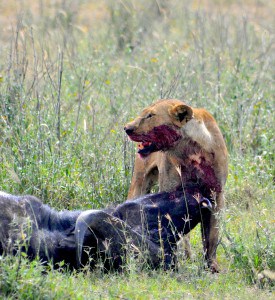Share this article
Cracking the Code of Predator-Prey Relations One Lion at a Time
A huge, healthy population of prey may be too much for predators to feast their eyes on — at least proportionately.
Researchers have discovered a widely applicable principle that could explain the maximum carrying capacity of predators that a given prey base could support.
“What we now have is a baseline for how many predators there should be, given a certain amount of prey,” said Ian Hatton, who was a PhD student at McGill University while working on a study recently published in Science. “All these different ecosystems lined up along this pattern.”
Hatton began by studying large mammals across protected areas of Africa. He compared published studies on the number of lions and other predators in the Kalahari Desert, which doesn’t have much prey to go around, with those of the Ngorongoro Crater — a lush area packed with wildebeest and other prey.
“We gathered as much data as we could,” Hatton said, adding that a lot has been published since the 1950s.
He and the other researchers found a “very striking” pattern: The number of predators didn’t increase proportionately with the number of prey.
In the Ngorongoro Crater, which Hatton said has one of the highest densities of prey on the planet, “there are three times less predators for every pound of prey,” he said.
But the declining ratio of predators seemed to match closely with another statistic.
As populations of most animals increase in a given area, things become crowded, and the proportion of overall reproduction begins to drop. For a lion this means that there are more able-bodied adult wildebeests and less calves, which generally make for a comparatively easy meal.
“The constant stream of new food supporting the predator population decreases,” Hatton said. They had found their match.
From Africa to the World
The study didn’t stop with African mammals. Researchers gathered data from approximately 1,000 different predator-prey studies from ecosystems all over the world, including tigers in Southeast Asia, wolves and their prey from Alaska to Quebec, and even zooplankton eating algae in oceans and lakes.
“We also looked at production and biomass,” Hatton said. “Basically everywhere we looked we found this same pattern, this same mathematical function to describe this system.”
Carolyn Kurle, an assistant biology professor at the University of California-San Diego who has studied other predator-prey relations, said that this study puts a new twist on an old debate among ecologists about whether the natural world is governed through food webs from the top-down or bottom-up.
“With top-down regulation, predators keep their prey numbers low, which releases plants from excess herbivory which allows the world to be green,” Kurle said. Bottom-up regulation, on the other hand, says that “when systems are less productive, all levels of the food web above are kept in check.”
But this study shows that the control comes from the bottom up, but it is not linked to primary production as researchers usually assumed. “Highly productive regions support more prey, but the crowding lowers prey reproduction, which in turn helps keep predators in check.
She said the results of this study also show how useful long-term census data can be to large studies like this.
Header Image: Lions attack a buffalo.
Image Credit: Amoury Laporte









